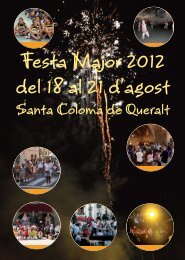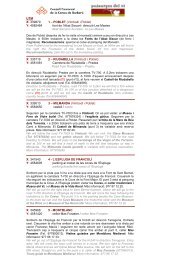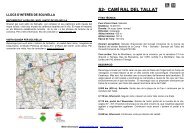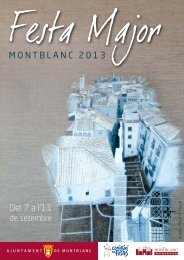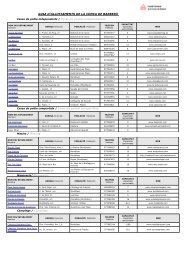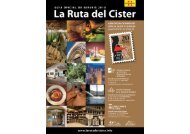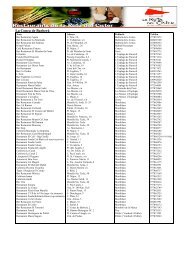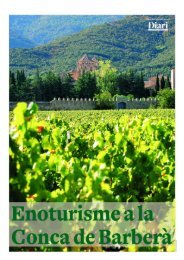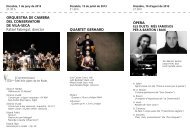8709 - MAPA BARBERÃ CARA - Turisme a la Conca
8709 - MAPA BARBERÃ CARA - Turisme a la Conca
8709 - MAPA BARBERÃ CARA - Turisme a la Conca
You also want an ePaper? Increase the reach of your titles
YUMPU automatically turns print PDFs into web optimized ePapers that Google loves.
COM<br />
ARRIBAR? R?<br />
- AP-2<br />
sortida 9 a Montb<strong>la</strong>nc, a 6km<br />
- AP-2<br />
sortida 10 al P<strong>la</strong> de Santa Maria, a 9 km<br />
- N-240<br />
de Montb<strong>la</strong>nc a Igua<strong>la</strong>da ada<br />
Lleida<br />
La Seu d’Urgell<br />
C-14<br />
Ba<strong>la</strong>guer<br />
C-25<br />
Manresa<br />
C-13<br />
A2 Tàrrega Cervera Igua<strong>la</strong>da<br />
AP-2 N-240<br />
C-241 A2<br />
MONTBLANC<br />
Valls AP-7<br />
C-32<br />
C-14 AVE El Vendrell<br />
N-240<br />
Reus<br />
Tarragona<br />
Vic<br />
AP-7<br />
Barcelona<br />
AP-7<br />
Vi<strong>la</strong>nova<br />
de Prades<br />
Rocafort<br />
de Queralt<br />
Senan<br />
C-14<br />
Solivel<strong>la</strong><br />
Sarral<br />
B<strong>la</strong>ncafort<br />
Ollers<br />
LA CO<br />
ONCA<br />
DE BARBERÀ<br />
RÀ<br />
Pira<br />
La Guàrdia<br />
Vimbodí L'Espluga<br />
de Francolí 9<br />
dels Prats AP-2<br />
Vallc<strong>la</strong>ra<br />
Les Masies<br />
POBLET MONTBLANC Prenafeta<br />
N-240<br />
C-14<br />
Els Cogullons Rojals<br />
Vi<strong>la</strong>verd<br />
Vallfogona<br />
de Riucorb Albió<br />
Montargull Aguiló<br />
Llorac La Cirera<br />
Segura Savallà Rauric<br />
Passanant<br />
del ComtatC-241d<br />
Sta. Coloma<br />
de Queralt<br />
Conesa<br />
Belltall<br />
Les Piles<br />
Forès<br />
Montbrió<br />
de <strong>la</strong> Marca<br />
BARBERÀ<br />
DE LA CONCA<br />
Les Roques<br />
d'Aguiló<br />
La Pob<strong>la</strong><br />
de Carivenys<br />
St. Magí de <strong>la</strong><br />
Brufaganya<br />
C-241d Biure<br />
de Gaià<br />
Vallverd Pontils<br />
BARBERÀ<br />
de Queralt<br />
Sta. Perpètua<br />
de Gaià<br />
Vallespinosa<br />
Seguer<br />
de <strong>la</strong> CONCA<br />
Les Eres<br />
PUNTS<br />
D’INTERÈS<br />
1<br />
2<br />
3<br />
4<br />
5<br />
6<br />
7<br />
8<br />
9<br />
10<br />
CASTELL<br />
Castillo - The Castle - The Château<br />
ESGLÉSIA<br />
Iglesia - The Curch - L’Église<br />
CELLER COOPERATIU MODERNISTA<br />
Bodega cooperativa modernista<br />
Modernist-style cooperative winery<br />
Cave coopérative de style Art Nouveau cata<strong>la</strong>n<br />
FONT VELLA<br />
AJUNTAMENT<br />
Ayuntamiento - Town Hall - Mairie<br />
ÀREA DE LLEURE ”LA MARINADA”<br />
ZONA ESPORTIVA<br />
Zona recreativa “La Marinada” - Zona esportiva<br />
“La Marinada” sports and recreational area<br />
Zone de loisirs “La Marinada” - Zone sportive<br />
PRIMER CELLER COOPERATIU<br />
DE CATALUNYA<br />
Primera Bodega cooperativa de Cataluña<br />
The first cooperative winery in Catalonia<br />
Première cave coopérative de Catalogne<br />
PORTAL DE CAL MANEL DEL MAGRE<br />
ALBERG “La Societat”<br />
Albergue “La Societat”<br />
“La Societat” hostel<br />
Auberge “La Societat”<br />
EL PORTAL<br />
Ruta a peu (30 min.)<br />
Ruta a pié - Walking tour - Route à pied<br />
AP-7<br />
Tortosa<br />
A Poblet<br />
A Vallbona de les Monjes<br />
7<br />
Carrer Hort d’en Cirera<br />
Av. de <strong>la</strong> <strong>Conca</strong><br />
Carrer Nou<br />
Carrer Nou<br />
C. Anselm C<strong>la</strong>vé<br />
Carrer Nou<br />
9<br />
Carrer Mig<br />
Carrer Comerç<br />
10<br />
C. de <strong>la</strong> Societat<br />
C. Mig<br />
Carrer Grau<br />
C. de <strong>la</strong> Societat<br />
C. de <strong>la</strong> Riba<br />
Carrer J. Esplugas<br />
Carrer de <strong>la</strong> Societat<br />
C. Grau<br />
Castell<br />
1<br />
Costa Mateu<br />
Carrer Nou<br />
Hort del Rector<br />
Carrer del Bruc<br />
C. J. Prim<br />
5<br />
Pl. Hospital<br />
3<br />
Carrer Major<br />
6<br />
4<br />
Carrer El Promasó<br />
8<br />
C. de l’Esglèsia<br />
C.del Bruc<br />
C. Sant Victorià<br />
2<br />
Carrer Comerç<br />
Carrer de <strong>la</strong> Font<br />
C. St. Victorià<br />
Carrer de Sant Victorià<br />
Carrer Almirall<br />
Raval del Castell<br />
Carrer dels Horta<strong>la</strong>ns<br />
Carrer a Forès<br />
Carrer dels Horta<strong>la</strong>ns<br />
Costa d’en Francesc<br />
C. de Piquetes<br />
Carrer Valldemur<br />
Camí a Sarral<br />
El Calvari<br />
Camí de les Aubaredes<br />
Carrer a Cabra<br />
C. Primer de Maig<br />
Carrer Comerç<br />
Cementiri<br />
A Santes Creus<br />
Camí de Santa Anna<br />
TOSSAL DE LES FORQUES<br />
www.barberade<strong>la</strong>conca.cat
EL CASTELL<br />
D’un castell del segle XI, Barberà conserva <strong>la</strong> torre cilíndrica i part del recinte. El 1132, Barberà<br />
fou donat als templers que hi organitzaren una comanda i ampliaren el castell per l’est.<br />
D’aquest, que tenia dues p<strong>la</strong>ntes i terrassa emmerletada, es conserven els baixos i <strong>la</strong> capel<strong>la</strong>.<br />
Extingit el Temple, el 1317 passà a l'Orde de l'Hospital. El comanador fra Guillem de Guimerà<br />
l’amplià pel nord amb el desaparegut "pa<strong>la</strong>u nou". El castell fou dels hospitalers fins a <strong>la</strong><br />
Desamortització del XIX, en què fou cedit al municipi per a esco<strong>la</strong> pública.<br />
Del castillo del siglo XI, Barberà conserva <strong>la</strong> torre cilíndrica y parte del recinto. En 1132, Barberà<br />
perteneció a <strong>la</strong> Orden del Temple quienes ampliaron el castillo por el este. De éste, que tenía dos p<strong>la</strong>ntas<br />
y terraza almenada, se conservan los bajos y <strong>la</strong> capil<strong>la</strong>. Extinguida <strong>la</strong> Orden del Temple, en 1317 pasó a <strong>la</strong> Orden del Hospital. Al comendador<br />
fra Guillem de Guimerà lo amplió por el norte con el desaparecido "pa<strong>la</strong>cio nuevo". El castillo fue de los hospita<strong>la</strong>rios hasta <strong>la</strong> Desamortización<br />
del XIX, en el que fue cedido al municipio para escue<strong>la</strong> pública..<br />
Of the 11th century Castle of Barberà, the cylindrical tower and part of the enclosure remain. In 1132, Barberà was handed over to the Knights<br />
Temp<strong>la</strong>r, who set up a command post there and extended the castle towards the east. Of this section, which had two floors and a crenel<strong>la</strong>ted<br />
terrace, the ground floor and the chapel still remain. Following the break-up of the Temp<strong>la</strong>r Order, the castle passed into the hands of the<br />
Hospitaller Order in 1317. Its commander, Brother Guillem de Guimerà, en<strong>la</strong>rged the castle on the northern side by the now-vanished “new<br />
pa<strong>la</strong>ce”. The castle belonged to the Hospitallers until the Disentailment of the 19th century when it was taken over by the municipal council for<br />
use as a public school.<br />
Barberà conserve <strong>la</strong> tour cylindrique et une partie de l’enceinte d’un château daté du XIe siècle. En 1132, le fief de Barberà a été donné aux<br />
Templiers qui y ont organisé une commanderie et ont agrandi le château par l’est. Seules les parties du rez-de-chaussée et <strong>la</strong> chapelle sont<br />
conservées de ce château, qui était à deux étages et possédait une terrasse crénelée. Une fois disparu l’Ordre des Templiers, il passe en 1317 à<br />
l'Ordre des Hospitaliers. Le commandeur frère Guillem de Guimerà l’agrandit vers le nord avec le « pa<strong>la</strong>is nouveau », disparu de nos jours. Le<br />
château a appartenu aux Hospitaliers jusqu’à <strong>la</strong> vente des biens ecclésiastiques du XIXe siècle, époque à <strong>la</strong>quelle il a été cédé à <strong>la</strong> commune<br />
pour en faire une école publique.<br />
L'ESGLÉSIA PARROQUIAL DE SANTA MARIA<br />
Edifici barroc construït a finals del XVIII, que té a <strong>la</strong> porta<strong>la</strong>da un timpà romànic procedent de l’anterior temple. És de<br />
p<strong>la</strong>nta rectangu<strong>la</strong>r i tres naus cobertes de volta de canó amb llunetes. Hi destaquen el campanar –extraordinària ta<strong>la</strong>ia de<br />
35 m–, <strong>la</strong> façana de corbes dinàmiques rococós i <strong>la</strong> porta<strong>la</strong>da de columnes exemptes. El timpà romànic, obrat<br />
probablement el segle XII, és una peça de notable qualitat artística, on s’hi veuen <strong>la</strong> Mare de Déu i Jesús a <strong>la</strong> falda<br />
esquerra, envoltats de l’ametl<strong>la</strong> mística i dos àngels que l’aguanten.<br />
Edificio barroco construido a finales del XVIII, que tiene en el portalón un tímpano románico procedente del<br />
anterior templo. Es de p<strong>la</strong>nta rectangu<strong>la</strong>r y tres naves cubiertas de vuelta de cañón con lunetas. Destacan el<br />
campanario -extraordinaria ata<strong>la</strong>ya de 35 m-, <strong>la</strong> fachada de curvas dinámicas rococó y el portalón de<br />
columnas exentas. El tímpano románico, obrado probablemente el siglo XII, es una pieza de notable calidad<br />
artística, donde se ven Madre de Dios y Jesús en el regazo izquierdo, rodeados de <strong>la</strong> almendra mística y dos<br />
ángeles que lo aguantan.<br />
This Baroque building, dating from the end of the 18th century, has a Romanesque tympanum at the main entrance which is a relic from the<br />
former church. It is rectangu<strong>la</strong>r in shape with three naves topped by tunnel vaulting with windows. Notable features include the bell-tower – a<br />
stunning watchtower 35 metres high – the façade with its powerful Rococo curves, and the main entrance with its freestanding columns. The<br />
Romanesque tympanum, probably made during the 12th century, has tremendous artistic value and shows the Mother of God and Jesus on her<br />
<strong>la</strong>p surrounded by a mandor<strong>la</strong> with two angels supporting it.<br />
Construit à <strong>la</strong> fin du XVIIIe siècle, ce bâtiment baroque présente un portail à tympan roman provenant du temple antérieur. L’église est à p<strong>la</strong>n<br />
rectangu<strong>la</strong>ire, avec trois nefs couvertes d’une voûte en plein cintre et des lunettes. Il faut en souligner le clocher – d’une extraordinaire hauteur de<br />
35 m –, <strong>la</strong> façade aux courbes dynamiques de style rococo et le portail à colonnes dégagées. Le tympan roman, œuvre sans doute du XIIe siècle,<br />
est une pièce d’une grande qualité artistique ; il représente <strong>la</strong> Vierge et le Christ sur son genou gauche, entourés d’une mandorle et de deux anges<br />
qui <strong>la</strong> soutiennent.<br />
ELS CELLERS COOPERATIUS<br />
L'any 1894, en el context reivindicatiu camperol de <strong>la</strong> Unió de Rabassaires, es constituí a Barberà <strong>la</strong> Societat de Trebal<strong>la</strong>dors Agrícoles.<br />
Aquesta associació, l'any 1898 construí un local social ("<strong>la</strong> Casa") i el 1900 un celler (el sindicat "dels pobres"). Aquest fou el primer celler<br />
cooperatiu de Catalunya. És un edifici molt funcional constituït bàsicament per moll de descàrrega, sa<strong>la</strong> de premses i transformació, i naus<br />
d'estibatge amb cups i tines. El 1913 els propietaris del poble, moguts per l'èxit assolit per <strong>la</strong> Societat, constituïren el Sindicat Agríco<strong>la</strong> de<br />
Barberà, entitat que el 1919 aixecà el seu propi celler. Realitzà l'obra l'arquitecte gaudinista César Martinell. El celler és un edifici de<br />
notable categoria arquitectònica. És especialment bel<strong>la</strong> <strong>la</strong> torre del dipòsit de l'aigua que Martinell dissenyà inspirada<br />
en el campanar setcentista de l'església parroquial.<br />
El año 1894, en el contexto reivindicativo campesino de <strong>la</strong> Unión de Rabassaires, se constituyó en Barberà <strong>la</strong> Societat de<br />
Trebal<strong>la</strong>dors Agrícoles. Esta asociación, el año 1898 construyó un local social ("<strong>la</strong> Casa") y <strong>la</strong> 1900 una<br />
bodega (el sindicato "de los pobres"). Ésta fue <strong>la</strong> primera bodega cooperativa de Cataluña. Es un<br />
edificio muy funcional constituido básicamente por muelle de descarga, sa<strong>la</strong> de prensas y<br />
transformación, y <strong>la</strong>gares y tinas. En 1913 los propietarios del pueblo, movidos por el éxito<br />
alcanzado por <strong>la</strong> Sociedad, constituyeron al Sindicato Agríco<strong>la</strong> de Barberà, entidad que en 1919<br />
levantó su propia bodega. Realizó <strong>la</strong> obra el arquitecto gaudinista César Martinell. La bodega es<br />
un edificio de notable categoría arquitectónica. Es especialmente bel<strong>la</strong> <strong>la</strong> torre del depósito del<br />
agua que Martinell diseñó inspirada en el campanario de <strong>la</strong> iglesia parroquial.<br />
In 1894, as part of the rural movement of the Unió de Rabassaires (tenant farmers and sharecroppers’ union), the Sociedad de Trabajadores<br />
Agríco<strong>la</strong>s (Agricultural Workers’ Association) was established in Barberà. In 1898 the association built its headquarters ("La Casa") and in 1900<br />
it established a winery (the union of "the poor"). This was the first cooperative winery in Catalonia. It is a highly functional building consisting<br />
essentially of the loading bay, the grape-pressing and winemaking hall, and packing warehouses with presses and vats. In 1913 the town’s<br />
<strong>la</strong>ndowners, prompted by the success of the Association, set up the Sindicat Agríco<strong>la</strong> de Barberà (Barberà Agricultural Union) which in 1919<br />
opened its own winery. This building was designed by architect César Martinell, a disciple of Gaudí, and is of outstanding architectural value.<br />
The tower of the water tank is particu<strong>la</strong>rly beautiful, for which Martinell was inspired by the eighteenth century bell-tower of the parish<br />
church.<br />
En 1894, au sein du contexte revendicatif agricole de l’Unió de Rabassaires (Union des arracheurs de souches), est constituée à Barberà <strong>la</strong><br />
Sociedad de Trabajadores Agríco<strong>la</strong>s (Société des Travailleurs Agricoles). En 1898, cette association construit un local social (« La Casa ») et en<br />
1900 une cave (le syndicat « des pauvres »). Il s’agit de <strong>la</strong> première cave coopérative de Catalogne. C’est un bâtiment très fonctionnel constitué<br />
essentiellement d’un quai de décharge, d’une salle de pressage et de transformation, et de hangars de stockage avec des fouloirs et des cuves.<br />
En 1913, les propriétaires terriens du vil<strong>la</strong>ge, poussés par le succès atteint par <strong>la</strong> Société, constituent le Syndicat Agricole de Barberà, un<br />
organisme qui en 1919 bâtit sa propre cave. L’œuvre est réalisée par l’architecte César Martinell, artiste s’inscrivant dans le courant de Gaudí.<br />
La cave est un bâtiment ayant une importante catégorie architecturale. Il faut tout particulièrement souligner <strong>la</strong> beauté de <strong>la</strong> tour du réservoir<br />
d’eau que Martinell conçoit en s’inspirant du clocher de l’église paroissiale datée du XVIIe siècle.<br />
"LA CASA" DE LA SOCIETAT<br />
El 1898, quatre anys després de <strong>la</strong> fundació de <strong>la</strong> Societat de Trebal<strong>la</strong>dors Agrícoles de Barberà, amb el concurs dels socis, pagesos i<br />
paletes, es construí el local social conegut popu<strong>la</strong>rment com “<strong>la</strong> Casa”. Fou una construcció humil però projectada amb un alt nivell de<br />
pragmatisme. El local esdevingué centre recreatiu i cultural que acollí, entre d'altres serveis, una esco<strong>la</strong> <strong>la</strong>ica per als fills dels associats.<br />
L’any 1939, <strong>la</strong> dictadura franquista el c<strong>la</strong>usurà i d’aleshores ençà sofrí una progressiva degradació<br />
que en feu témer <strong>la</strong> ruïna. Afortunadament, quan complia cent anys el poble l’ha<br />
recuperat.<br />
En 1898, cuatro años después de <strong>la</strong> fundación de <strong>la</strong> Sociedad de Trabajadores Agríco<strong>la</strong>s de<br />
Barberà, con el concurso de los socios, campesinos y albañiles, se construyó el local social<br />
conocido popu<strong>la</strong>rmente como "<strong>la</strong> Casa". Fue una construcción humilde pero proyectada<br />
con un alto nivel de pragmatismo. El local se convirtió en centro recreativo y cultural que<br />
acogió, entre otros servicios, una escue<strong>la</strong> <strong>la</strong>ica para los hijos de los asociados. El año 1939,<br />
<strong>la</strong> dictadura franquista lo c<strong>la</strong>usuró y desde entonces sufrió una progresiva degradación<br />
que hagáis temer <strong>la</strong> ruina. Afortunadamente, cuando cumplía cien años el pueblo lo ha recuperado.<br />
In 1898, four years after the Sociedad de Trabajadores Agríco<strong>la</strong>s (Agricultural Workers’ Association) of Barberà was founded, its members,<br />
farmers and <strong>la</strong>bourers alike, all got together to build its headquarters, which would become popu<strong>la</strong>rly known as “La Casa”. Although it was a<br />
very simple structure, it was p<strong>la</strong>nned from a standpoint of practicality. The premises became a recreational and cultural centre which housed a<br />
secu<strong>la</strong>r school for members’ children amongst other facilities. In 1939 it was closed down by the Franco dictatorship, from which time it became<br />
more and more derelict until it was feared it would end up in ruins. Fortunately, on its hundredth anniversary the town restored the building.<br />
En 1898, quatre ans après <strong>la</strong> fondation de <strong>la</strong> Sociedad de Trabajadores Agríco<strong>la</strong>s (Société des Travailleurs Agricoles) de Barberà, avec le<br />
concours des membres, de paysans et de maçons, le local social connu popu<strong>la</strong>irement sous le nom de « La Casa » est construit. Il s’agit d’une<br />
construction humble mais projetée avec un très haut niveau de pragmatisme. Le local devient un centre de loisirs et de culture qui accueille,<br />
entre autres services, une école <strong>la</strong>ïque pour les enfants des associés. En 1939, <strong>la</strong> dictature franquiste ferme le local qui commence alors à souffrir<br />
une dégradation progressive qui lui fait courir le risque de tomber en ruines. Heureusement, le vil<strong>la</strong>ge l’a réhabilité coïncidant avec ses cent ans.<br />
LA FONT VELLA<br />
La "Font Vel<strong>la</strong>" de Barberà està situada a <strong>la</strong> sortida del poble, a l'inici de l'antic camí de Pira, on el segle XVIII foren construïts uns<br />
rentadors públics, dissortadament enderrocats fa pocs anys, i un abeurador per a les cavalleries. Documentada des de l'any 1175 és <strong>la</strong><br />
font on tot el poble anava a buscar aigua abans no s'instal·lés l'aigua corrent. Al davant de <strong>la</strong> font hi ha una còpia de <strong>la</strong> creu de terme<br />
gòtica, que es trobava a l'ermita de Santa Anna, actualment exposada al Museu Comarcal. El segle XVIII Barberà tenia sis creus de terme.<br />
La "Fuente Vieja" de Barberà está situada en <strong>la</strong> salida del pueblo, al inicio del antiguo camino de Pira, donde el siglo XVIII serían construidos<br />
unos <strong>la</strong>vadores públicos, derribados hace pocos años, y un abrevadero para <strong>la</strong>s caballerías. Documentada desde el año 1175 es <strong>la</strong> fuente<br />
donde todo el pueblo iba a buscar agua antes no se insta<strong>la</strong>ra el agua corriente. Ante <strong>la</strong> fuente hay una copia de <strong>la</strong> cruz de término gótica, que<br />
se encontraba en <strong>la</strong> ermita de Santa Anna, actualmente expuesta en el Museo Comarcal. El siglo XVIII Barberà tenía seis cruces de término.<br />
The Font Vel<strong>la</strong> (Old Spring) of Barberà stands on the edge of the town at the beginning of the old road to Pira, where in the eighteenth century<br />
some public <strong>la</strong>undry facilities were built, unfortunately demolished a few years ago, and a drinking trough for horses. Having appeared in<br />
documents as far back as 1175, this was the spring where the whole vil<strong>la</strong>ge used to come to fetch water before running water was installed. In<br />
front of the spring there is a copy of the municipality’s Gothic preaching cross which was found in the<br />
chapel of Santa Anna, currently on exhibit in the County Museum. Back in the 18th century,<br />
Barberà had six preaching crosses.<br />
La Font Vel<strong>la</strong> (Vieille Fontaine) de Barberà est située à <strong>la</strong> sortie du vil<strong>la</strong>ge, au début de l’ancien<br />
chemin de Pira, où ont été construits au XVIIIe siècle des <strong>la</strong>voirs publics, malheureusement<br />
détruits il y a quelques années, et un abreuvoir pour chevaux. Documentée dès 1175, c’est ici<br />
que tout le vil<strong>la</strong>ge venait chercher de l’eau avant l’instal<strong>la</strong>tion de l’eau courante. Devant <strong>la</strong><br />
fontaine se trouve une copie de <strong>la</strong> croix de délimitation gothique, qui se trouvait dans l’ermitage<br />
de Santa Anna, actuellement exposée au Musée Cantonal. Au XVIIIe siècle, Barberà possédait<br />
six croix de délimitation.<br />
OLLERS<br />
Llogaret agregat a Barberà de <strong>la</strong> <strong>Conca</strong>. Entre els segles<br />
XII i XIX fou membre de les comandes templera i<br />
hospitalera de Barberà. Actualment, amb <strong>la</strong> majoria de<br />
cases restaurades, el lloc ha esdevingut ideal per a<br />
segona residència i estiueig.<br />
Pequeño pueblo agregado a Barberà de <strong>la</strong> <strong>Conca</strong>. Entre los<br />
siglos XII y XIX fue miembro de <strong>la</strong> Orden del Temple y de los<br />
Caballeros Hospita<strong>la</strong>rios. Actualmente, <strong>la</strong> mayoría de<br />
casas están restauradas, por lo que se ha convertido en un<br />
lugar ideal de segunda residencia y de veraneo.<br />
A hamlet attached to Barberà de <strong>la</strong> <strong>Conca</strong>. Between the<br />
12th and 19th centuries it belonged to the Temp<strong>la</strong>r and<br />
Hospitaller Orders of Barberà. Today, now that most of its<br />
houses have been renovated, it has become the ideal spot<br />
for a weekend or summer home.<br />
Lieu-dit rattaché à Barberà de <strong>la</strong> <strong>Conca</strong>. Entre les XIIe et<br />
XIXe siècles, il a appartenu aux commandeurs templiers et<br />
hospitaliers de Barberà. Actuellement, <strong>la</strong> plupart des<br />
maisons ayant été restaurées, le lieu est idéal pour avoir<br />
une seconde résidence et y aller en villégiature.<br />
VISITES GUIADES<br />
VISITAS GUIADAS / GUIDED TOURS / VISITES GUIDEÉS<br />
Dissabtes a les 11.00h i a les 17.00h. Diumenges a les 11.00h.<br />
Resta de dies, visites concertades.<br />
Sábados a <strong>la</strong>s 11.00h i a <strong>la</strong>s 17.00h. Domingos a <strong>la</strong>s 11.00h.<br />
Demás días, visitas concertadas.<br />
Saturdays at 11.00am and 17.00pm. Sundays at 11.00am.<br />
Rest of days, concerted visits.<br />
Samedis à 11.00h et à 17.00h. Dimanches à 11.00h.<br />
Reste du jours, visites concertées.<br />
Reserves / Reservas / Reservations / Réservers: Tel. 977 87 12 47<br />
- Castell, Església i Celler modernista (inclou tast de vins).<br />
- Castillo, iglesia y bodega modernista (incluye cata de vinos).<br />
- Castle, The Church and cave cooperative de style Art Nouveau cata<strong>la</strong>n and<br />
Modernist-style cooperative winery (trying wine included).<br />
- The Château, l’Église and le Cave coopérative de style Art Nouveau<br />
cata<strong>la</strong>n (avec dégustation du vins).<br />
ALLOTJAMENTS<br />
ALOJAMIENTOS / ACCOMODATION / HÉBERGEMENT<br />
La Societat (allotjament municipal). C. Societat, 37 - Tel. 977 88 70 10<br />
aj.barbera@altanet.org - www.barberade<strong>la</strong>conca.cat<br />
FESTES<br />
FIESTAS / PARTIES / FÊTES<br />
- Festa Major, penúltim dissabte d’agost / Penúltimo sábado de agosto<br />
On penultimate saturday of august / Un Samedi avant-dernier d’août .<br />
- Festa del Roser, 1r dissabte de maig / Primer Sábado de Mayo<br />
On the first Saturday of May / le premier Samedi de mai.<br />
- Festa del Castell, juny / junio / june / juin.<br />
ADRECES D’INTERÈS<br />
www.barberade<strong>la</strong>conca.cat<br />
www.concaturisme.cat<br />
www.<strong>la</strong>rutadelcister.info<br />
© TGD Rovira i Valls<br />
Ajuntament de Barberà de <strong>la</strong> <strong>Conca</strong> 2009



